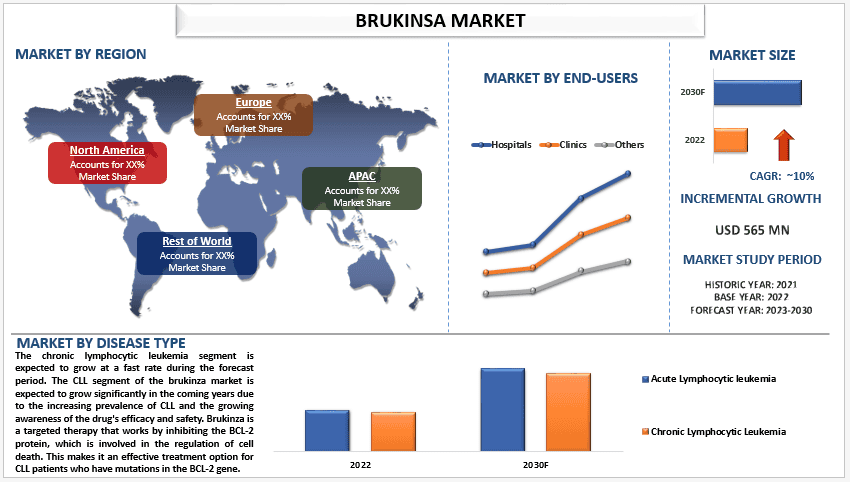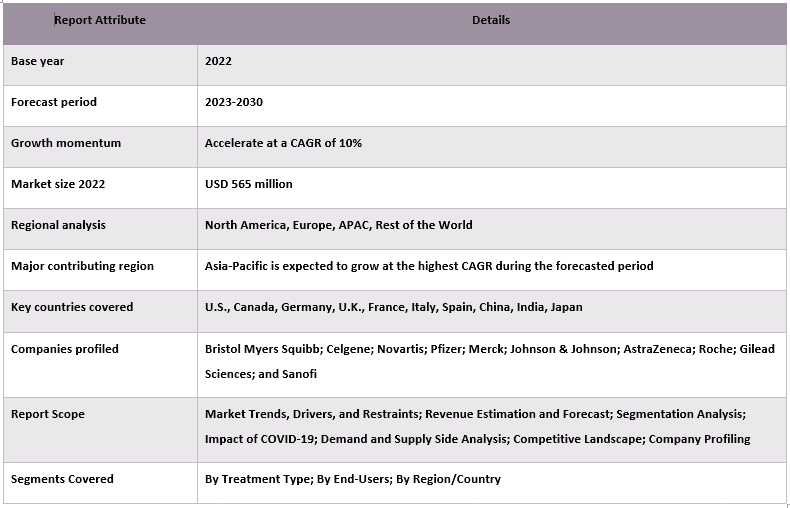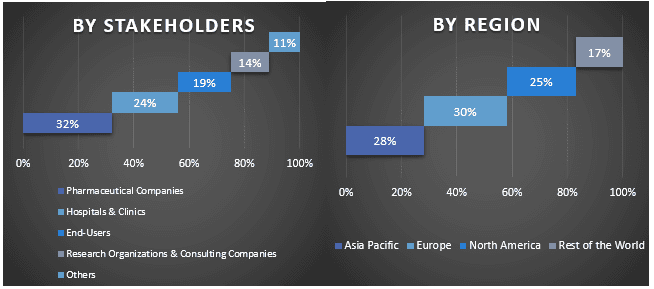- الرئيسية
- معلومات عنا
- صناعة
- الخدمات
- قراءة
- اتصل بنا
سوق Brukinsa: التحليل الحالي والتوقعات (2023-2030)
التركيز على نوع المرض (ابيضاض الدم الليمفاوي الحاد وابيضاض الدم الليمفاوي المزمن)؛ المستخدمون النهائيون (المستشفيات والعيادات وغيرهم)؛ والمنطقة/البلد

بلغت قيمة سوق Brunkinsa 565 مليون دولار أمريكي في عام 2022 ومن المتوقع أن ينمو بمعدل نمو سنوي مركب قوي يبلغ حوالي 6٪ خلال الفترة المتوقعة (2023-2030). Brukinsa هو دواء يستخدم لعلاج ابيضاض الدم الليمفاوي الحاد (ALL)، وهو نوع من سرطان الدم الذي يصيب الأطفال والبالغين. ينمو سوق brukinza بسرعة بسبب زيادة انتشار ALL وزيادة الوعي بفعالية الدواء وسلامته. من المتوقع أن ينمو سوق brukinza العالمي بشكل كبير في السنوات القادمة، مدفوعًا بالطلب المتزايد على خيارات العلاج الفعالة لـ ALL والتواجد المتزايد للاعبين الرئيسيين في السوق. من المتوقع أن يغذى السوق بالانتشار المتزايد لـ ALL في البلدان النامية، فضلاً عن الوعي المتزايد بفعالية الدواء وسلامته.
تشمل بعض اللاعبين الرئيسيين العاملين في السوق Bristol Myers Squibb؛ Celgene؛ Novartis؛ Pfizer؛ Merck؛ Johnson & Johnson؛ AstraZeneca؛ Roche؛ Gilead Sciences؛ و Sanofi. تم إجراء العديد من عمليات الدمج والاستحواذ إلى جانب الشراكات من قبل هؤلاء اللاعبين لتسهيل حصول العملاء على منتجات/تقنيات مبتكرة وعالية التقنية.
الرؤى المقدمة في التقرير
"من بين أنواع الأمراض، من المتوقع أن ينمو قطاع ابيضاض الدم الليمفاوي المزمن بمعدل سريع خلال الفترة المتوقعة"
استنادًا إلى نوع المرض، يتم تقسيم السوق إلى ابيضاض الدم الليمفاوي الحاد وابيضاض الدم الليمفاوي المزمن. من بين هؤلاء، من المتوقع أن ينمو قطاع ابيضاض الدم الليمفاوي المزمن بمعدل سريع خلال الفترة المتوقعة. من المتوقع أن ينمو قطاع CLL في سوق brukinza بشكل كبير في السنوات القادمة بسبب زيادة انتشار CLL وزيادة الوعي بفعالية الدواء وسلامته. Brukinza هو علاج موجه يعمل عن طريق تثبيط بروتين BCL-2، الذي يشارك في تنظيم موت الخلايا. هذا يجعله خيارًا علاجيًا فعالًا لمرضى CLL الذين لديهم طفرات في جين BCL-2.
"من بين المستخدمين النهائيين، من المتوقع أن تنمو العيادات بمعدل نمو سنوي مركب مرتفع خلال الفترة المتوقعة"
استنادًا إلى المستخدمين النهائيين، تم تصنيف السوق إلى مستشفيات وعيادات وغيرها. من بين هؤلاء، من المتوقع أن تنمو العيادات بمعدل نمو سنوي مركب مرتفع خلال الفترة المتوقعة. من المتوقع أن يكون قطاع العيادات في سوق brukinza مدفوعًا بالطلب المتزايد على خيارات العلاج الفعالة لـ ALL و CLL والتواجد المتزايد للاعبين الرئيسيين في السوق. من المتوقع أن يكون السوق شديد التنافسية، مع وجود عدد كبير من اللاعبين الرئيسيين العاملين في السوق. يشمل هؤلاء اللاعبون Bristol Myers Squibb و Celgene و Novartis و Pfizer و Merck، من بين آخرين. تعتبر هذه الشركات جميعها لاعبين مهمين في صناعة الأدوية العالمية وملتزمة بتطوير علاجات مبتكرة للمرضى الذين يعانون من ALL و CLL.
"سيطرت منطقة آسيا والمحيط الهادئ على سوق Brunkinsa في عام 2022"
تعد منطقة آسيا والمحيط الهادئ موطنًا لعدد كبير من السكان ومن المتوقع أن تكون سوقًا رئيسيًا لـ brukinza بسبب زيادة انتشار ابيضاض الدم الليمفاوي الحاد (ALL) وابيضاض الدم الليمفاوي المزمن (CLL) في المنطقة. من المتوقع أن ينمو سوق brukinza في آسيا والمحيط الهادئ بشكل كبير في السنوات القادمة بسبب زيادة الطلب على خيارات العلاج الفعالة لـ ALL و CLL والوعي المتزايد بفعالية الدواء وسلامته. Brukinza هو علاج موجه يعمل عن طريق تثبيط بروتين BCL-2، الذي يشارك في تنظيم موت الخلايا. هذا يجعله خيارًا علاجيًا فعالًا للمرضى الذين يعانون من ALL و CLL
تغطية تقرير سوق Brunkinsa

أسباب شراء هذا التقرير:
- تتضمن الدراسة تحليل حجم السوق والتنبؤ به تم التحقق منه من قبل خبراء الصناعة الرئيسيين الموثوق بهم.
- يقدم التقرير مراجعة سريعة للأداء العام للصناعة في لمحة.
- يغطي التقرير تحليلاً متعمقًا لنظراء الصناعة البارزين مع التركيز الأساسي على البيانات المالية التجارية الرئيسية ومحافظ المنتجات واستراتيجيات التوسع والتطورات الأخيرة.
- فحص مفصل للدوافع والقيود والاتجاهات الرئيسية والفرص السائدة في الصناعة.
- تغطي الدراسة السوق بشكل شامل عبر قطاعات مختلفة.
- تحليل متعمق على المستوى الإقليمي للصناعة.
خيارات التخصيص:
يمكن تخصيص سوق Brunkinsa العالمي بشكل أكبر وفقًا للمتطلبات أو أي قطاع سوق آخر. إلى جانب ذلك، تدرك UMI أن لديك احتياجات عمل خاصة بك، لذا لا تتردد في الاتصال بنا للحصول على تقرير يناسب متطلباتك تمامًا.
جدول المحتويات
منهجية البحث لتحليل سوق برونكينسا (2023-2030)
كان تحليل السوق التاريخي وتقدير السوق الحالي والتنبؤ بالسوق المستقبلي لسوق برونكينسا العالمي هي الخطوات الرئيسية الثلاث التي تم اتخاذها لإنشاء وتحليل اعتماد برونكينسا في المناطق الرئيسية على مستوى العالم. تم إجراء بحث ثانوي شامل لجمع أرقام السوق التاريخية وتقدير حجم السوق الحالي. ثانيًا، للتحقق من صحة هذه الرؤى، تم أخذ العديد من النتائج والافتراضات في الاعتبار. علاوة على ذلك، تم إجراء مقابلات أولية شاملة مع خبراء الصناعة عبر سلسلة القيمة لسوق برونكينسا العالمي. بعد افتراض أرقام السوق والتحقق من صحتها من خلال المقابلات الأولية، استخدمنا نهجًا تصاعديًا / تنازليًا للتنبؤ بحجم السوق الكامل. بعد ذلك، تم اعتماد طرق تقسيم السوق وتثليث البيانات لتقدير وتحليل حجم سوق القطاعات والقطاعات الفرعية ذات الصلة بالصناعة. يتم شرح المنهجية التفصيلية أدناه:
تحليل حجم السوق التاريخي
الخطوة 1: دراسة متعمقة للمصادر الثانوية:
تم إجراء دراسة ثانوية تفصيلية للحصول على حجم السوق التاريخي لسوق برونكينسا من خلال مصادر الشركة الداخلية مثل التقارير السنوية والبيانات المالية وعروض الأداء والنشرات الصحفية وما إلى ذلك، والمصادر الخارجية بما في ذلك المجلات والأخبار والمقالات والمنشورات الحكومية ومنشورات المنافسين وتقارير القطاعات وقاعدة بيانات الطرف الثالث والمنشورات الموثوقة الأخرى.
الخطوة 2: تجزئة السوق:
بعد الحصول على حجم السوق التاريخي لسوق برونكينسا، أجرينا تحليلًا ثانويًا مفصلاً لجمع رؤى السوق التاريخية وحصتها للقطاعات والقطاعات الفرعية المختلفة للمناطق الرئيسية. يتم تضمين القطاعات الرئيسية في التقرير كنوع المرض والمستخدمين النهائيين. تم إجراء المزيد من التحليلات على مستوى الدولة لتقييم الاعتماد الكلي لنماذج الاختبار في تلك المنطقة.
الخطوة 3: تحليل العوامل:
بعد الحصول على حجم السوق التاريخي للقطاعات والقطاعات الفرعية المختلفة، أجرينا تحليل عوامل مفصلاً لتقدير حجم السوق الحالي لسوق برونكينسا. علاوة على ذلك، أجرينا تحليلًا للعوامل باستخدام المتغيرات التابعة والمستقلة مثل نوع المرض والمستخدمين النهائيين لسوق برونكينسا. تم إجراء تحليل شامل لسيناريوهات جانب الطلب والعرض مع مراعاة أهم الشراكات وعمليات الدمج والاستحواذ والتوسع التجاري وإطلاق المنتجات في قطاع سوق برونكينسا في جميع أنحاء العالم.
تقدير حجم السوق الحالي والتنبؤ به
تحديد حجم السوق الحالي: بناءً على رؤى قابلة للتنفيذ من الخطوات الثلاث المذكورة أعلاه، توصلنا إلى حجم السوق الحالي واللاعبين الرئيسيين في سوق برونكينسا العالمي والحصص السوقية للقطاعات. تم تحديد جميع تقسيمات الحصص المئوية المطلوبة وتقسيمات السوق باستخدام النهج الثانوي المذكور أعلاه وتم التحقق منها من خلال المقابلات الأولية.
التقدير والتنبؤ: لتقدير السوق والتنبؤ به، تم تخصيص أوزان لعوامل مختلفة بما في ذلك المحركات والاتجاهات والقيود والفرص المتاحة لأصحاب المصلحة. بعد تحليل هذه العوامل، تم تطبيق تقنيات التنبؤ ذات الصلة، أي النهج التصاعدي / التنازلي، للوصول إلى توقعات السوق لعام 2030 للقطاعات والقطاعات الفرعية المختلفة عبر الأسواق الرئيسية على مستوى العالم. تشمل منهجية البحث المعتمدة لتقدير حجم السوق ما يلي:
- حجم سوق الصناعة، من حيث الإيرادات (بالدولار الأمريكي) ومعدل اعتماد سوق برونكينسا عبر الأسواق الرئيسية محليًا
- جميع الحصص المئوية وتقسيمات وتقسيمات قطاعات السوق والقطاعات الفرعية
- اللاعبون الرئيسيون في سوق برونكينسا العالمي من حيث المنتجات المعروضة. أيضًا، استراتيجيات النمو التي يتبناها هؤلاء اللاعبون للتنافس في السوق سريع النمو
التحقق من صحة حجم السوق وحصته
البحث الأولي: تم إجراء مقابلات متعمقة مع قادة الرأي الرئيسيين (KOLs) بما في ذلك كبار المديرين التنفيذيين (CXO/VPs، رئيس المبيعات، رئيس التسويق، رئيس العمليات، الرئيس الإقليمي، الرئيس القطري، إلخ) عبر المناطق الرئيسية. ثم تم تلخيص نتائج البحوث الأولية وإجراء تحليل إحصائي لإثبات الفرضية المذكورة. تم دمج المدخلات من البحث الأولي مع النتائج الثانوية، وبالتالي تحويل المعلومات إلى رؤى قابلة للتنفيذ.
تقسيم المشاركين الرئيسيين في مناطق مختلفة

هندسة السوق
تم استخدام تقنية تثليث البيانات لإكمال تقدير السوق الإجمالي والوصول إلى أرقام إحصائية دقيقة لكل قطاع وقطاع فرعي من سوق برونكينسا العالمي. تم تقسيم البيانات إلى عدة قطاعات وقطاعات فرعية بعد دراسة مختلف المعايير والاتجاهات في مجالات نوع المنتج والتطبيق وقناة التوزيع في سوق برونكينسا العالمي.
الهدف الرئيسي من دراسة سوق برونكينسا العالمي
تم تحديد اتجاهات السوق الحالية والمستقبلية لسوق برونكينسا العالمي في الدراسة. يمكن للمستثمرين اكتساب رؤى استراتيجية لترسيخ تقديرهم للاستثمارات على التحليل النوعي والكمي الذي تم إجراؤه في الدراسة. حددت اتجاهات السوق الحالية والمستقبلية الجاذبية الإجمالية للسوق على المستوى الإقليمي، مما يوفر منصة للمشارك الصناعي لاستغلال السوق غير المستغلة للاستفادة من ميزة المحرك الأول. تشمل الأهداف الكمية الأخرى للدراسات ما يلي:
- تحليل حجم السوق الحالي والمتوقع لسوق برونكينسا من حيث القيمة (بالدولار الأمريكي). أيضًا، تحليل حجم السوق الحالي والمتوقع للقطاعات والقطاعات الفرعية المختلفة
- تشمل القطاعات في الدراسة مجالات نوع المرض والمستخدمين النهائيين
- تحديد وتحليل الإطار التنظيمي لصناعة برونكينسا
- تحليل سلسلة القيمة التي تنطوي على وجود وسطاء مختلفين، إلى جانب تحليل سلوكيات العملاء والمنافسين في الصناعة
- تحليل حجم السوق الحالي والمتوقع لسوق برونكينسا للمنطقة الرئيسية
- تشمل الدول الرئيسية في المناطق التي تمت دراستها في التقرير آسيا والمحيط الهادئ وأوروبا وأمريكا الشمالية وبقية العالم
- ملفات تعريف شركات سوق برونكينسا واستراتيجيات النمو التي يتبناها اللاعبون في السوق للاستمرار في السوق سريع النمو
- تحليل متعمق على المستوى الإقليمي للصناعة
ذات صلة التقارير
العملاء الذين اشتروا هذا المنتج اشتروا أيضًا










